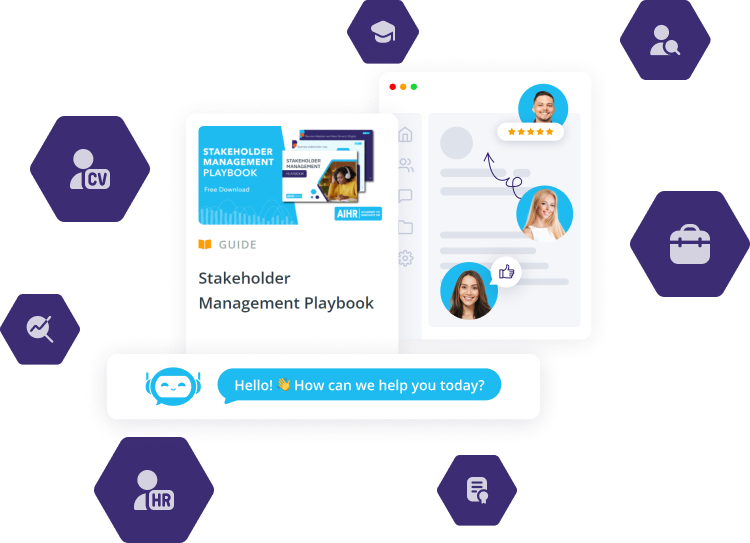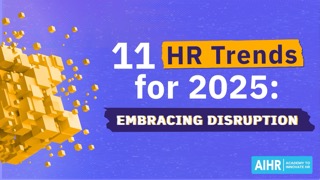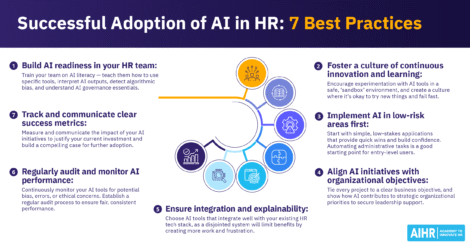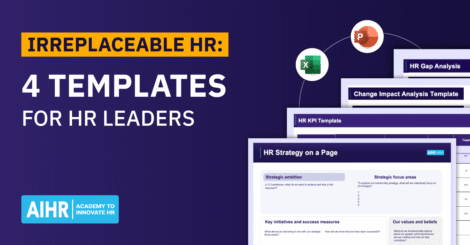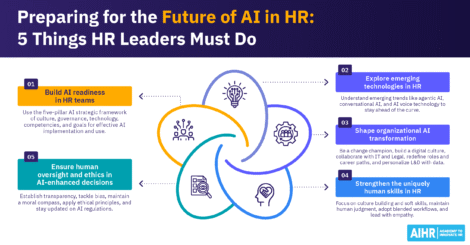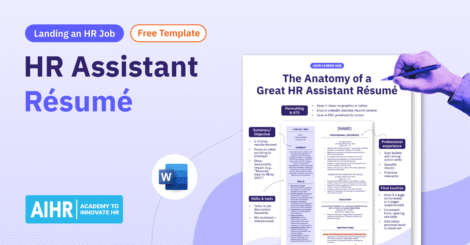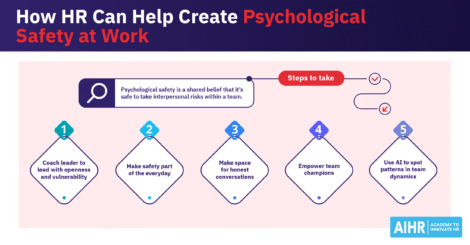An HR roadmap might seem like just one more process in an already incredibly busy week, month, and year, but this is far more than a planning tool. It’s a strategic guide that helps HR professionals make meaningful, measurable progress in HR’s maturity. Without a structured approach, HR initiatives can quickly become scattered, reactive, and overwhelming, making it difficult to align with broader business objectives.
By taking a deliberate, sequential approach to workforce planning, talent development, and operational efficiencies, HR teams can make sure that every initiative contributes to long-term success rather than becoming just another disconnected task.
Contents
What is an HR roadmap?
7 reasons why your organization needs an HR roadmap
What to include in your HR roadmap
HR roadmap examples
Developing and implementing your HR roadmap
What is an HR roadmap?
An HR roadmap is a strategic plan outlining the key initiatives, priorities, and actions that advance the HR function within an organization. It serves as a guide to achieving the next level of HR maturity, ensuring HR progresses from a transactional role to a strategic business enabler.
An HR roadmap gives a clear, step-by-step approach to strengthening HR’s impact on workforce performance, talent management, and business outcomes. It aligns HR strategies with organizational goals, helping HR leaders transition from basic administrative functions to proactive, data-driven partners in business decision-making. An HR roadmap typically supports organizations in:
- Strategic planning and prioritization so that HR initiatives align with business objectives and drive long-term success
- Creating a structured approach to talent acquisition, retention, and workforce development to facilitate business growth
- Defining HR budgets, personnel, and technology investments for maximum impact
- Advancing HR maturity by moving HR from a reactive function to a strategic center, driving workforce performance and business resilience
- Incorporating technology like AI and automation, and analytics to enhance HR efficiency and decision-making
- Developing policies and programs that enhance employee engagement, satisfaction, and productivity
- Establishing HR governance structures that align with regulations and mitigate workforce-related risks.
7 reasons why your organization needs an HR roadmap
A well-structured HR roadmap is the foundation of a resilient and forward-thinking workforce strategy. Rather than reacting to challenges as they arise, HR professionals who follow a clear roadmap can proactively shape policies, talent strategies, and employee initiatives to align with long-term business goals.
Here are 7 ways HR roadmaps help the HR function mature and deliver results:
1. Ensuring HR initiatives are proactive rather than reactive
Without a structured HR roadmap, many HR teams constantly put out fires instead of working toward long-term goals. A roadmap provides clarity and foresight, letting HR leaders anticipate challenges and implement proactive solutions.
Rather than reacting to workforce issues like high turnover, skill shortages, or compliance risks as they arise, businesses with a roadmap can implement strategies to mitigate them before they become critical. This approach lets HR shape the workforce strategically, preparing the organization for shifts in the business environment.
2. Helping HR teams prioritize tasks and allocate resources effectively
HR departments often have a lot on their plate, juggling recruitment, employee engagement, compliance, performance management, and more. An HR roadmap ensures teams focus on high-impact initiatives rather than spreading resources too thin.
By outlining priorities, timelines, and resource allocation, HR professionals can avoid inefficiencies and make sure budget, time, and personnel are invested where they’ll deliver the most value. This, in turn, lets HR leaders make a strong business case for investments in new technology, training, or workforce planning by demonstrating alignment with broader organizational goals.
3. Aligning HR functions with business goals to drive long-term success
For HR to be effective, it must align with the business strategy rather than operate in isolation. An HR roadmap ensures HR’s initiatives support key business objectives like scaling operations, improving profitability, or enhancing employer branding.
Whether a company focuses on rapid expansion, digital transformation, or workforce optimization, the roadmap keeps HR working towards the same end goal. This alignment is critical in building a resilient workforce that can adapt to market changes and business growth while maintaining productivity and engagement.
An HR roadmap is only as strong as the team behind it. Whether you’re planning your HR strategy or digital transformation, your roadmap requires more than intention—it requires enablement.
AIHR for Teams helps HR leaders build high-performing, future-ready HR teams by giving them access to expert-led, online training across strategic HR domains. Help your team grow together to drive lasting business impact!
4. Improving employee experience and retention through structured HR initiatives
A well-defined HR roadmap helps organizations create a positive employee experience by implementing initiatives that drive engagement, career development, and workplace satisfaction.
Instead of reacting to employee dissatisfaction or high turnover, businesses with a clear roadmap proactively invest in learning and development programs, performance management, and workplace culture initiatives. Employees benefit from a consistent, well-communicated HR strategy that prioritizes their growth, wellbeing, and success.
5. Enhancing HR’s strategic role in business decision-making
Are you interested in contributing valuable insights to executive discussions and using workforce data and predictive analytics to influence decisions? An HR roadmap helps HR professionals do exactly that. Whether it’s workforce planning, succession strategies, or change management, an HR roadmap delivers data-driven recommendations that enhance business resilience and agility.
Companies can navigate industry disruptions and maintain a competitive edge by transforming HR from an operational function into a trusted business advisor.
6. Supporting organizational agility and change management
Agile companies are built on HR strategies that are flexible, scalable, and responsive to changing needs. With a clear roadmap, HR teams can anticipate changes, from digital transformation to hybrid work models, and develop plans to support employees. This reduces uncertainty, enhances change adoption, and ensures organizational resilience.
7. Driving measurable HR success through KPIs and continuous improvement
Instead of implementing HR programs without success metrics, businesses can use the HR roadmap to define Key Performance Indicators (KPIs) like employee engagement scores, retention rates, or time-to-hire metrics. This data-driven approach supports continuous refinement and optimization of HR strategies based on performance insights. Plus, a culture of continuous improvement helps organizations make informed decisions that enhance workforce efficiency, business performance, and long-term sustainability.
What to include in your HR roadmap
By this stage, it should be clear that a well-structured HR roadmap is a strategic blueprint for how HR works at and for your organization. It guides HR teams to align their initiatives with business goals, optimize workforce performance, and enhance employee experience.
To ensure its effectiveness, your HR roadmap should include key elements that provide clarity, structure, and measurable progress. Let’s take a closer look at these elements.
Strategy and vision
Every HR roadmap needs a clear strategy and vision that aligns the HR function with the business’s goals. This section should outline the long-term HR strategy, reflecting the company’s mission, values, and priorities. Whether focusing on scaling operations, improving retention, supporting a high-performance culture, or driving digital transformation, the roadmap should articulate HR’s contribution to these objectives.
Key focus areas to consider including:
- Talent acquisition and workforce planning: Outline a strategic approach to hiring, succession planning, and talent pipeline development to meet business demands.
- Employee engagement and wellbeing: Create initiatives that drive job satisfaction, work-life balance, and workplace culture.
- Learning and development (L&D): Implement programs to upskill employees, enhance leadership capabilities, and support career progression.
- HR technology and digital transformation: Use HR systems, automation, and analytics to boost efficiency and data-driven decision-making.
- Performance management and culture: Establish frameworks for performance reviews, goal setting, and building a culture of continuous improvement.
- Compliance and risk management: Make sure HR policies align with legal and regulatory requirements to minimize risk and enhance governance.
HR pro tip
Each focus area should have specific objectives, initiatives, and action plans for structured execution.
Timelines and milestones
A roadmap is effective only if it includes a timeline with defined milestones to track progress. HR initiatives should have short-term, mid-term, and long-term goals with realistic deadlines. This ensures accountability, prevents delays, and allows adjustments based on business needs.
Key milestone examples include:
- Rolling out a new HR technology platform
- Launching a leadership development program
- Implementing a new employee engagement framework.
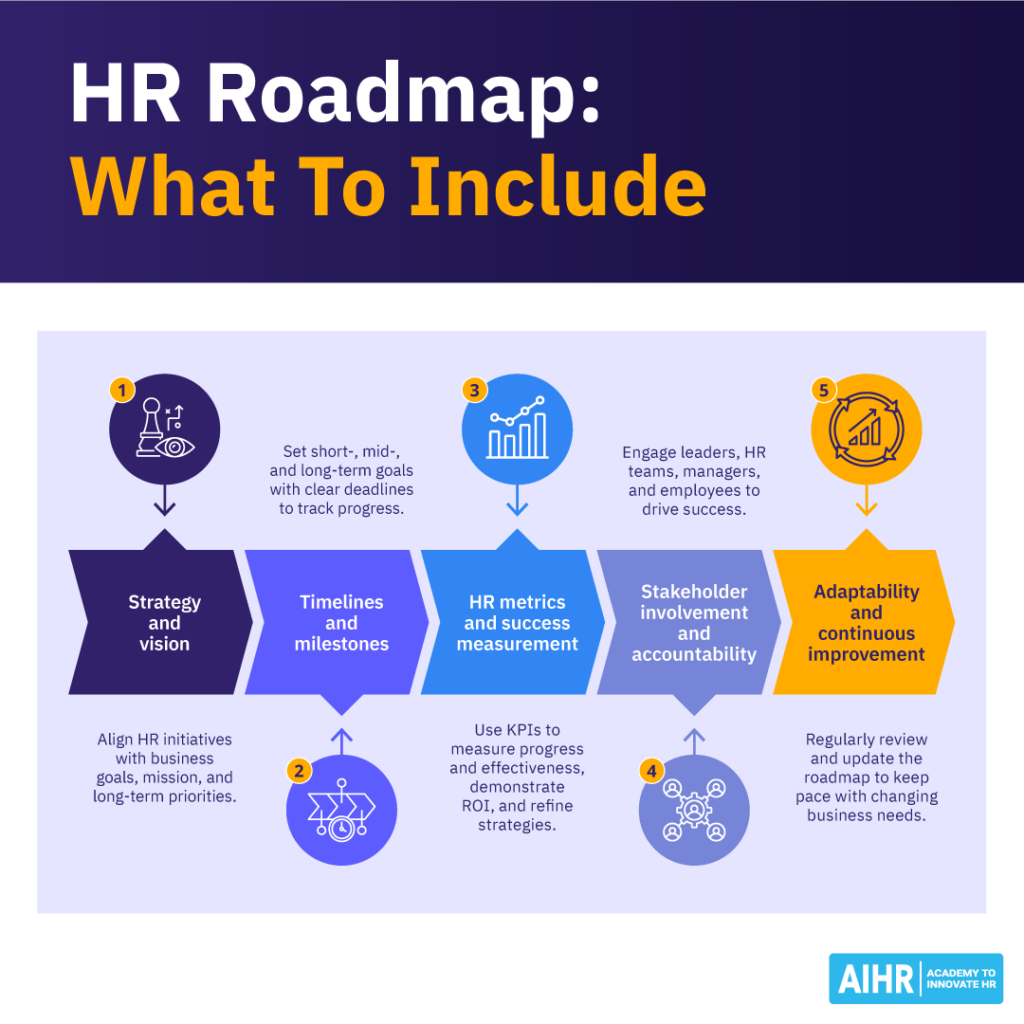
HR metrics and success measurement
The roadmap should include clear Key Performance Indicators (KPIs) and success metrics to evaluate HR initiatives. These metrics let HR teams track progress, demonstrate ROI, and refine strategies based on data-driven insights.
Key metrics:
- Talent acquisition: Time-to-hire, cost-per-hire, quality of hire
- Employee engagement: Employee Net Promoter Score (eNPS), survey participation rates
- Retention and turnover: Employee retention rates, voluntary vs. involuntary turnover
- L&D effectiveness: Training completion and internal promotion rates
- Diversity and inclusion: Representation across employee levels, pay equity.
Stakeholder involvement and accountability
For an HR roadmap to succeed, it must involve key stakeholders at different organizational levels, ensuring alignment and shared responsibility.
Stakeholders include:
- Executive leadership: Providing strategic direction and approving HR investments.
- HR team: Driving implementation and ensuring alignment with HR best practices.
- Managers and team leaders: Champions of HR programs, ensuring employee participation and engagement.
- Employees: Providing feedback and insights to refine HR strategies.
Adaptability and continuous improvement
Business environments, workforce expectations, and industry trends constantly evolve, so an HR roadmap must remain flexible and adaptable. It should include a framework for regular reviews, feedback loops, and updates to ensure HR strategies remain relevant.
Key tools:
- Quarterly assessments
- Pulse surveys
- Benchmarking against industry best practices.
HR roadmap examples
As an HR professional, you can design different types of roadmaps based on your organization’s needs, challenges, and maturity level. Whether the goal is to transform HR into a strategic function, implement new technology, or support business growth, the right roadmap provides clarity and direction. Below are common HR roadmaps, each tailored to a specific focus area.
1. HR strategy roadmap
An HR strategy roadmap provides a high-level overview of how HR will support business objectives over a set timeframe. It aligns HR functions with key business priorities, such as workforce planning, leadership development, and organizational culture. A strategy roadmap is ideal for HR leaders transitioning from an administrative function to a strategic business partner.
Key characteristics:
- Defines HR’s strategic priorities and initiatives
- Aligns HR with the company’s long-term business strategy
- Covers talent acquisition, employee engagement, workforce planning, and compliance
- Includes key milestones, timelines, and success metrics.
2. HR digital transformation roadmap
As businesses adopt technology-driven HR practices, an HR digital transformation roadmap guides the transition from traditional HR processes to automated, data-driven, and AI-enhanced operations. This roadmap is essential for organizations looking to optimize HR processes, reduce manual work, and improve employee experiences through technology.
Key characteristics:
- Focuses on modernizing HR operations through digital tools
- Covers automation, AI recruitment, self-service HR portals, and employee experience platforms
- Defines a phased implementation approach for technology adoption
- Ensures HR teams are trained, and change management strategies are in place
- Implements HR technology to automate and streamline processes.
3. HR technology roadmap
An HR technology roadmap is more specific than a digital transformation roadmap, focusing solely on technology selection, integration, and implementation for HR functions.
Key characteristics:
- This section details the implementation of HR systems, like Human Resources Information Systems (HRIS), payroll software, and talent management platforms
- Outlines key technology investments, integration plans, and vendor selection
- Addresses data security, compliance, and system compatibility
- Defines KPIs to measure technology adoption and effectiveness.
4. HR analytics roadmap
An HR analytics roadmap leverages workforce data and predictive insights to improve HR decision-making and planning and benefits HR teams transitioning from gut-feel decision-making to a data-driven approach.
Key characteristics:
- Outlines how HR will collect, analyze, and use employee data
- Defines key metrics like turnover rates, engagement scores, and hiring effectiveness
- Incorporates workforce planning models, AI analytics, and benchmarking
- Ensures compliance with data privacy regulations.
5. HR roadmap for a startup
Startups typically have limited HR resources, making it essential to create a roadmap that prioritizes foundational HR functions while remaining agile, helping startups establish structured HR practices while maintaining flexibility to adapt as the business scales.
Key characteristics:
- Focuses on hiring, onboarding, and compliance as immediate priorities
- Establishes basic HR policies, contracts, and compensation structures
- Outlines a plan for building an early-stage company culture
- Defines a scalable HR approach as the company grows.
6. HR roadmap for a scaleup
A scaleup roadmap is for rapidly growing businesses needing to mature their HR function to support expansion. HR professionals operating in fast-growing businesses transitioning from ad-hoc HR to a structured, scalable HR function need a roadmap that supports long-term sustainability.
Key characteristics:
- Focuses on scaling recruitment to support business growth
- Develops leadership programs to strengthen management capabilities
- Introduces structured performance management, career development, and retention strategies
- Enhances employer branding and employee experience initiatives.
Here’s a full example of the HR roadmap for a scaleup:
Developing and implementing your HR roadmap
Creating and executing an HR roadmap requires a structured approach to aligning HR initiatives with business goals, prioritizing effectively, and delivering measurable impact. Here are the steps you should follow to develop an actionable, adaptable roadmap that drives long-term success.
1. Assess current HR practices and identify gaps
Before developing an HR roadmap, evaluate the current HR functions and identify areas for improvement. Conduct an HR maturity assessment to understand how HR processes, policies, and technologies compare to industry best practices.
Engage with employees, managers, and leadership to collect feedback on pain points, inefficiencies, and workforce challenges. Finally, review your HR metrics, including turnover, time to hire, and engagement scores, to help identify which areas need improvement.
2. Determine key focus areas
Once gaps are identified, define the key focus areas for the HR roadmap. These should align with business priorities and address workforce needs.
Common areas include:
- Talent acquisition and workforce planning
- Employee engagement and wellbeing
- Learning and development
- HR technology and digital transformation
- Performance management and culture
- Compliance and risk management.
HR pro tip
Prioritize areas with the most immediate and long-term impact.
3. Define clear, measurable goals
Clear goals provide direction, accountability, and a way to track progress. Setting specific, measurable, achievable, relevant, and time-bound (SMART) goals ensures a results-driven roadmap.
Examples include:
- Reduce employee turnover by 15% in 12 months through enhanced retention strategies
- Implement a digital HR management system to automate payroll and performance reviews within six months
- Increase employee engagement scores by 20% over the next year through leadership development and recognition programs.
4. Engage stakeholders and secure buy-in
Successful HR roadmaps require support from executive leadership, department managers, and employees. Engage key stakeholders early to ensure alignment and secure buy-in:
- Senior leadership: Ensure HR initiatives support overall business strategy.
- Managers: Gain their input on hiring needs, team development, and HR support.
- Employees: Collect feedback on engagement, learning opportunities, and workplace culture.
HR pro tip
Reduce resistance and boost collaboration by clearly communicating how the roadmap benefits the business and employees.
5. Create a realistic implementation plan (with buffers)
A well-planned roadmap should include a phased timeline with realistic deadlines and built-in flexibility to accommodate changes. Adding buffers keeps the roadmap adaptable without overwhelming HR teams.
Consider these timelines:
- Short-term (0–6 months): Quick wins, like launching an employee feedback survey or streamlining HR policies.
- Mid-term (6–12 months): Implementing HR technology, enhancing recruitment strategies, or improving onboarding.
- Long-term (12–24 months): Larger transformation projects, like leadership development programs or cultural transformation initiatives.
6. Focus on effective resource allocation
HR teams need the right budget, technology, and personnel to execute the roadmap effectively. It’s, therefore, important to outline resource requirements for effective planning and to make sure the roadmap meets timelines and budgets.
Considerations include:
- Financial investment: Budget for software, training, or external HR consultants.
- HR capacity: Are more HR team members needed to support execution?
- Technology needs: Selecting and implementing the right HR tools for automation, analytics, and employee self-service.
7. Manage stakeholder expectations
Set realistic expectations about HR initiatives’ scope, timeline, and impact. Leadership and employees should understand that transformation doesn’t happen overnight. Aligning expectations upfront also helps HR teams avoid resistance and maintain trust.
Communicate:
- What HR initiatives will be prioritized?
- How long will each phase take?
- What results and timeline can they expect?
8. Monitor progress and adjust
Regularly tracking progress keeps the HR roadmap on course. Use HR dashboards and analytics tools to measure performance against key KPIs, including:
- Recruitment efficiency (time to hire, cost per hire)
- Employee engagement scores
- Learning and development participation rates
- Retention and turnover trends.
HR pro tip
If data shows that specific initiatives aren’t delivering expected results, adjust the approach agilely. Quarterly reviews and stakeholder feedback can refine the roadmap.
9. Communicate progress and impact
Transparent communication builds credibility and demonstrates HR’s value in driving business success. Keeping stakeholders informed about HR initiatives ensures continued support and engagement. Regular updates—through reports, town halls, or newsletters—help showcase:
- Achievements (e.g., new L&D program launched, improved engagement scores)
- Challenges and adjustments
- Upcoming initiatives and next steps.
Wrapping up
If your goal is for HR to become a driving force in your organization’s business success, an HR roadmap is the place to start. Organizations can build a resilient, high-performing workforce by proactively shaping workforce strategies, aligning HR initiatives with business objectives, and continuously rising to meet new challenges.
Whether you’re focusing on talent acquisition, digital transformation, employee engagement, or compliance, a well-defined HR roadmap gives clarity, direction, and measurable impact. Investing in an HR roadmap today ensures your business is equipped to navigate change and drive long-term success.


